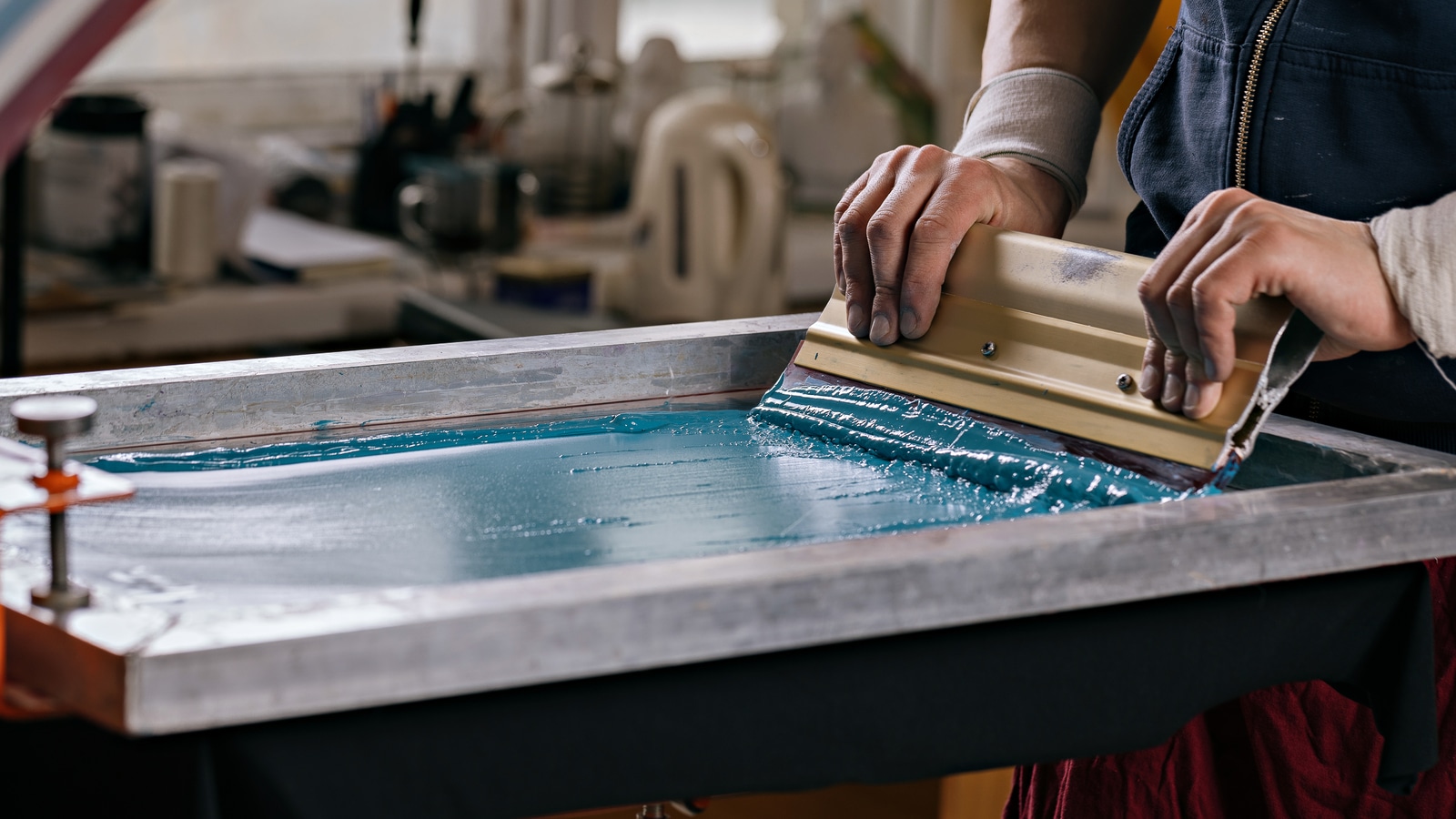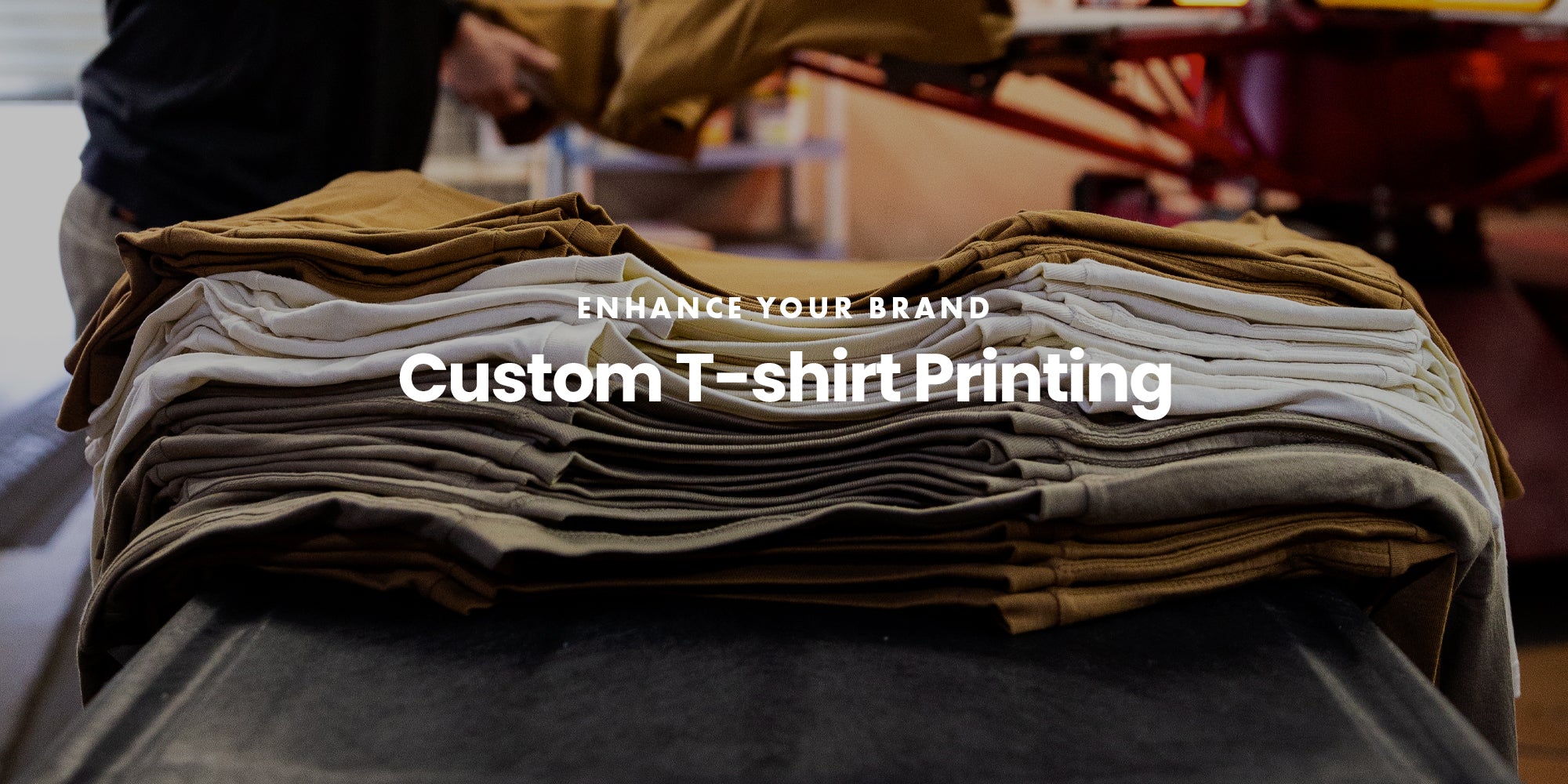Affordable Screen Printing Kit for Home Use
Affordable Screen Printing Kit for Home Use
Blog Article
Screen Printing Uncovered: Whatever You Required to Understand About Tee and Garment Printing Methods
If you've ever asked yourself just how those vivid designs wind up on your preferred tees, you're in the ideal area. Display printing is a remarkable method that combines art with technique, providing endless possibilities for creativity. Understanding the fundamentals, from tools to ink choices, can significantly impact your results. All set to check out the essential elements that make display printing an art form? Let's discover the details that can boost your jobs.
The Basics of Screen Printing: Exactly How It Works
When you plunge right into display printing, you'll discover it's both a science and an art. At its core, display printing entails creating a stencil, or display, that allows ink to pass via just in specific areas.
Position the screen over the material, after that utilize a squeegee to press ink with the display onto the garment. Each action is vital, and mastering them will certainly boost your display printing abilities, changing straightforward garments into special, meaningful items.
Sorts Of Screen Printing Techniques
Once you comprehend the essentials of screen printing, it's time to discover the different techniques that can raise your designs. One prominent method is standard screen printing, where ink is pushed with a stenciled screen.
One more alternative is plastisol printing, understood for its toughness and vibrant shades, making it a preferred for numerous brand names. Experiment with halftone printing to create slope results and complex styles.
Vital Equipment for Screen Printing
To accomplish sensational outcomes in screen printing, having the best devices is essential. You'll need a tough screen printing frame, which holds the mesh that transfers your layout onto the garment. Next, spend in top quality squeegees; these are important for applying ink uniformly throughout the display.
Selecting the Right Inks and Materials
When choosing inks and materials for screen printing, you need to take into consideration the kind of ink that functions ideal for your task. Consider material compatibility to ensure your styles look last and wonderful lengthy. Check out green ink options to make your printing procedure a lot more sustainable.
Kinds of Screen Inks
Selecting the best display ink is crucial for accomplishing lively, sturdy prints that fulfill your job's needs. There are a number of kinds of screen inks to check out. Plastisol ink is prominent for its flexibility and ease of usage, supplying outstanding shade opacity on dark fabrics. Water-based ink, on the other hand, provides a softer feeling and is environment-friendly, making it optimal for those seeking to minimize their environmental influence. Discharge inks get rid of dye from the material, causing a soft, classic look but need particular handling. Specialty inks, such as glow-in-the-dark or metal, can add special results to your layouts. Evaluate your job needs and select the ink that straightens finest with your desired end result.

Material Compatibility Considerations
Comprehending material compatibility is crucial for attaining top quality screen prints, specifically given that various products react distinctly to numerous inks. When selecting inks, think about the fabric type-- cotton, polyester, or blends. For cotton, water-based inks function well, using gentleness and breathability. Polyester, on the other hand, often calls for plastisol inks for better bond and lively shades. You could require to use a mix of both types if you're printing on blends. Always test your inks on example fabric to assure they adhere appropriately and maintain shade integrity. Additionally, remember that fabric weight and appearance can affect the last outcome, so selecting the right ink and product combo is crucial for your project's success.
Eco-Friendly Ink Options
Environmentally friendly inks are ending up being a preferred choice for display printers that intend to minimize their ecological effect while keeping top quality. When selecting inks, think about water-based inks, which are much less unsafe and much easier to clean up compared to standard solvents. These inks bond well with fabrics, providing vivid outcomes without toxic chemicals. You might additionally explore eco-solvent inks that utilize fewer unpredictable natural compounds (VOCs), making them a safer choice for both your health and wellness and the world.
In addition, seek inks made from renewable resources, such as soy or vegetable-based alternatives. By selecting the ideal inks and materials, you'll not only create spectacular styles however also add to a much more lasting printing procedure. Make the button, and your prints will reflect your dedication to the atmosphere!
Preparing Your Design for Display Printing

Submit Format Needs
To ensure your style looks sharp and vibrant on fabric, you'll require to pay close focus to file style needs for screen printing. Beginning with vector files like AI or EPS, as they can be scaled without losing top quality. If you use raster images, go with high-resolution documents, such as TIFF or PNG, ideally at 300 DPI. Prevent making use of JPEGs, as they can lose clarity when resized. Additionally, see to it your design has a transparent history to stop unwanted white edges on your prints. Maintain shade modes in mind; CMYK is basic for screen printing, so convert your RGB develops appropriately - screen printing kit. By complying with these guidelines, you'll set your artwork up for a successful print.
Color Separation Techniques
Color separation is a crucial step in preparing your layout for screen printing, and mastering it can significantly enhance your print top quality. You'll need to break your style into specific colors, as each shade requires a different screen throughout printing. This accuracy not only assures precise shade representation but likewise streamlines the printing procedure.
Resolution and Dimension
Attaining the most effective cause display printing begins with guaranteeing your style has the ideal resolution and size. Preferably, your art work should go to the very least 300 DPI (dots per inch) for sharp, clear prints. If you make use of reduced resolution, your end product might look pixelated and amateur.
When it comes to size, think about the dimensions of your print area. Layout your art work to match the final print size, ideally producing it in the real measurements you'll be publishing. By doing this, you'll avoid any type of unanticipated scaling issues.
Always check your style in both vector and raster formats. Vector graphics can be scaled without shedding top quality, making them perfect for screen printing. Preparing properly will ensure your design looks outstanding on every garment!
Step-by-Step Display Printing Process
Screen printing is a vibrant procedure that allows you to create dynamic designs on various surfaces. To start, you'll need a display, solution, and your picked ink. Initially, prepare your display by cleaning it thoroughly. Next off, apply the emulsion evenly and allow it completely dry in a dark area. As soon as completely dry, subject your screen to light with your layout positioned on it, which will set the solution where the light hits, developing a stencil - screen printing kit.
Pour ink onto the display and use a squeegee to push the ink through the pattern onto the textile. Raise the screen very carefully and allow the print completely dry. You have actually successfully screen published your style.
Tips for Effective Screen Printing Projects
While you're diving into your display printing projects, bear in mind that preparation is key to success. Start by gathering all your materials-- inks, screens, garments, and mops. A clean work space assists prevent undesirable errors, so clean up before you begin.
Following, confirm your artwork is high-resolution and properly sized for your garment. Check your display for proper direct exposure and clean it thoroughly to prevent spots. When mixing your inks, comply with the manufacturer's standards to accomplish the ideal uniformity.
During printing, apply also stress with your squeegee for constant outcomes. Do not rush; take your time to confirm each print satisfies your standards. After printing, allow your garments dry totally prior to taking care of or packaging them.
Last but not least, constantly maintain an example of your benefit future recommendation. This method, you can assess your progression and improve your methods gradually. Satisfied printing!

Frequently Asked Questions
The length of time Does It Take to Establish up a Display Printing Task?
Establishing up a display printing task normally takes around half an hour to an hour. You'll prepare the displays, mix inks, and change the press. The time differs based upon intricacy and experience, so remain arranged!
Can I Print on Different Textile Keys In Making Use Of the Very Same Strategy?
Yes, you can print on different textile types using the very same strategy, however you'll need to adjust your settings and inks. Some fabrics soak up ink in a different custom screen printing way, so trying out guarantees the very best outcomes for each and every product.
What Are Common Mistakes to Stay Clear Of in Screen Printing?
When screen printing, stay clear of typical blunders like making use of the incorrect ink, ignoring correct exposure times, or skipping pre-press checks. Constantly examine your setup and maintain clean screens to ensure quality results each time.
How Can I Effectively Tidy and Keep My Display Printing Tools?
To properly clean and preserve your screen printing devices, you must regularly clean screens with suitable solvents, inspect mops for wear, and guarantee all tools are stored dry and dust-free. Uniformity avoids expensive repair services and boosts efficiency.
Is Screen Printing Eco-friendly Contrasted to Other Approaches?
Screen printing can be more ecologically friendly than various other methods, particularly if you make use of water-based inks and eco-conscious materials. By choosing sustainable products and techniques, you lower waste and decrease your effect on the planet.
Screen Printing Uncovered: Every Little Thing You Need to Know Concerning Tee and Garment Printing Methods
At its core, display printing involves producing a pattern, or screen, that enables ink to pass through only in particular areas. Setting the display over the fabric, then utilize a squeegee to push ink through the screen onto the garment. One prominent approach is typical display printing, where ink is pushed via a stenciled screen.When choosing inks and materials for screen printing, you need to take right into account the kind of ink that works finest for your task.
Report this page